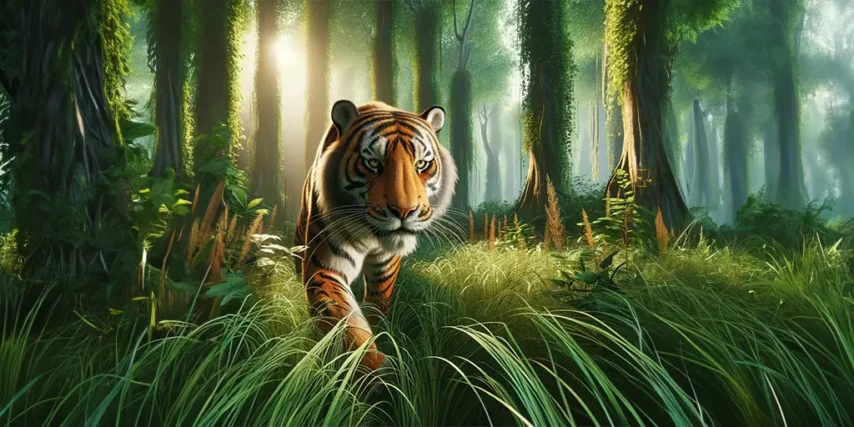The tiger (Panthera tigris) is one of the most iconic and powerful animals on the planet. As the largest member of the cat family, tigers are renowned for their strength, agility, and striking appearance. In this article, we’ll delve into the fascinating world of tigers, exploring their habitat, behavior, diet, and conservation status.
Habitat and Distribution
Tigers primarily inhabit the forests and grasslands of Asia. They are found in diverse environments ranging from the Siberian taiga to the mangrove swamps of the Sundarbans. Tigers are solitary and territorial animals, requiring large areas of habitat to support their prey and breeding needs. Key tiger habitats include:
- Tropical Rainforests: Dense jungles in Southeast Asia.
- Grasslands: Open plains where they hunt grazing animals.
- Savannas: Mixed environments of grass and scattered trees.
- Mangrove Swamps: Coastal areas like the Sundarbans.

Physical Characteristics
Tigers are easily recognized by their reddish-orange fur with distinctive black stripes. These stripes provide excellent camouflage in their natural habitat, breaking up their outline as they move through the forest. Each tiger’s stripe pattern is unique, much like human fingerprints. Tigers have powerful limbs, sharp retractable claws, and large canine teeth, making them formidable hunters.
- Size: Male tigers can weigh between 220 to 660 pounds (100 to 300 kg), while females are generally smaller.
- Length: They can measure up to 10 feet (3 meters) from head to tail.
- Coloration: Variations include the white tiger, which is a rare color morph.

Behavior and Social Structure
Tigers are primarily nocturnal, hunting during the night and resting during the day. They are solitary animals, with each individual occupying a large territory that they mark with scent markings and vocalizations. Despite their solitary nature, tigers communicate with each other through a variety of sounds, including roars, growls, and chuffing.
- Territorial: Males have larger territories that overlap with those of several females.
- Maternal Care: Female tigers are responsible for raising cubs, teaching them hunting skills.
- Communication: Vocalizations, scent markings, and visual signals are used to communicate.
Diet and Hunting
Tigers are carnivores, primarily preying on large ungulates such as deer, wild boar, and buffalo. They are ambush predators, relying on stealth and strength to catch their prey. A tiger’s diet can vary depending on its habitat and the availability of prey.
- Primary Prey: Deer, wild boar, and buffalo.
- Hunting Technique: Stalking and ambushing, using their powerful limbs and claws to bring down prey.
- Consumption: Can eat up to 88 pounds (40 kg) of meat in one meal.

Conservation Status
Tigers are listed as endangered by the International Union for Conservation of Nature (IUCN). Their populations have drastically declined due to habitat loss, poaching, and human-wildlife conflict. Conservation efforts are underway to protect tigers and their habitats, including anti-poaching measures, habitat restoration, and captive breeding programs.
- Threats: Habitat destruction, poaching, and illegal wildlife trade.
- Conservation Efforts: Protected areas, anti-poaching patrols, and community-based conservation programs.
- Population: Approximately 3,900 tigers remain in the wild.
Conclusion
Tigers are magnificent creatures that play a crucial role in maintaining the balance of their ecosystems. Conservation efforts are vital to ensure the survival of this majestic species for future generations. By supporting tiger conservation initiatives, we can help protect these iconic animals and their habitats.







